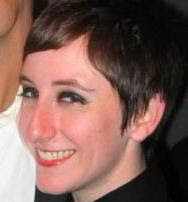Why hello there! My name is Sarah, and yes, as you see above, I am Your Favorite Museum Intern.
I am a 28 year old "adult learner" who returned a few years ago to college after a stint as a make up artist for a major cosmetics company (if 6 years is a stint). Life happens, and it was time to head in a different direction.
I was surprised to find out that I could get an actual
degree in regards to working in museums. I decided to go for it, also getting a degree in General Studies, at
Indiana University at Indianapolis. After leaving the cosmetics industry, I took on a job as a gallery director at a fine art gallery in Indy, called the
Domont Studio Gallery. I was lucky to have hardcore experience working in a fast paced environment of a for-profit art gallery. From this venue I gained contacts in the public and private sector, and had hands on experience of handling of objects, curating, artist relations, marketing, and more.
This is my final year in school, and I've done quite well for myself in regards to school. I came back in 2006 having to make up a 1.548 GPA from my first "attempt" at school just after high school graduation. I did bad in class, but I got an A+ in partying hard, I can tell you that. I now have a really great GPA, and I won't rub it in. It took a lot of hard work, and I am proud to say I'm a regular on the Dean's List and a "Roads Scholar" no, not a RHODES scholar. This means I get free parking on campus for a good consistent GPA. No Oxford for me, sadly.
Anyway, in the program we have to do a number of internships. I, luckily, had a great contact in
Jennifer Complo McNutt, the curator of Contemporary Art at the
Eiteljorg Museum. She also is the head of the museums amazing
Fellowship program, which brings contemporary Native Americans into the international spotlight by providing money and support, and then an epic show in the Fall of their years work at the museum (and it's by far one of the most groundbreaking and innovative art fellowship programs in the world, and she works her butt off, as does everyone here involved for this program). Jennifer was able to put me in contact with
Amy McKune, Director of Museum Collections at the
Eiteljorg. Amy weaseled me in to the collections department, and I have been interning here since February.
I work alongside
Crista Pack, Conservation Technician, and yes, that is a link to an article in the New York Times that has Crista in it. Yes, New York Times! Anyway, we work together to document, catalog, photograph, stare at and conserve. She does the fancy conservation work, I just take some nice photos, stare at nice photos, and stow away the nice photos.
My main task, which is overseen by Amy and
Dr. Larry Zimmerman, my mentor, is rehousing and organizing
photogravures by the infamous
Edward S. Curtis. We have over 700 Curtis' in our collection, and I have taken on the task of housing them in archival boxes, in an organized fashion, and making sure there are images of each piece in our handy program, The Museum System (this is sort of like a computer library of all the objects a museum has and the info to go with each item). Since the copyright expired on these pieces, instead of photographing almost 800 photos, I am taking them off the Library of Congress
website (and yes, giving credit to them in
TMS) and taking photographs of items that have conservation issues, or are not on the website (only a few). This allows for curators and collections staff to easily gain access to the images, without having to disrupt the objects by
unnecessary handling.
So, on that note, today is actually my last day here. In the Fall I will be coming back to do more work, and finish my project, thanks to the awesome staff here at the museum being so flexible.
Why am I leaving? Well, I decided to apply at two other plays for internships:
The National Muesum of the American Indian, at the Smithsonian in D.C. and
Colonial Williamsburg in Virginia. To my surprise I got both. So, this week, Friday, I will be leaving Indianapolis to head off to Colonial Williamsburg to work with
Buck Woodard of their public history department's American Indian Initiative. Here we will be working with Native communities to incorporate their historical and contemporary stories into CW and Virginia public history programs.
Then, I leave for DC and from June 1-August 7 I will be living on George Washington University campus and working at the NMAI's research facility in Maryland doing research work in regards to an upcoming exhibit. This is a dream come true for me!
So, a long story short, here you can learn about my projects, my life as I meld into the museum industry, and struggles and non-struggles. I will be documenting my experiences at historical and cultural venues throughout the Southeast, as well. My work goals focus on Native American and minority representation in public history - and my writings will document that greatly.
Ok, back to work!



